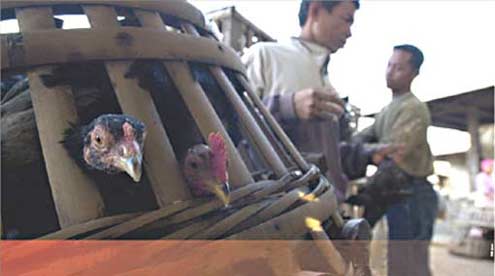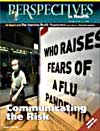Bird Flu:
Communicating the Risk
by Peter M. Sandman and Jody Lanard
Health authorities want to spread the word that avian influenza has brought the world perilously close to a new flu pandemic. But raising awareness about uncertain threats can itself be perilous. Two leading risk communication experts offer advice on how to sound the alarm.

Poultry await sale at a livestock market in Indonesia. More than 140 million birds have died or been destroyed in the Asian bird flu epidemic. Estimates of potential deaths from an eventual human pandemic range from 2 million to nearly 100 million. (FAO photo)
Public health officials have a pandemic-size communication problem. Experts believe a deadly influenza pandemic is quite likely to be launched by the H5N1 avian virus that has killed millions of birds and dozens of people in Asia. They are more anxious than they have been in decades. But infectious diseases are unpredictable. H5N1 could disappear-as swine flu did in 1976-and "The Great Pandemic of 2___" could arise from a strain that doesn't even exist yet. Even if H5N1 does cause a human pandemic, it might weaken and produce only mild disease. So it's hard for officials to know how aggressively to sound the alarm. They don't want to be accused of needlessly frightening the public. They also don't want to be accused-later-of leaving the public underprepared for a disaster.
Communication wouldn't be such a problem if it were possible to get ready for the next pandemic without talking to the public. It isn't. Health authorities want the public to be aware of this grave threat for three fundamental reasons: so people will prepare themselves emotionally and logistically; so people will help their schools, businesses, hospitals, and other organizations prepare; and so people will support the preparedness efforts of their governments. And there's a fourth reason: If and when a pandemic begins, people who have had time to get used to the idea are likelier to understand their risks, follow official advice, and take an active role in protecting themselves.
Officials don't want to be accused of needlessly frightening the public. They also don't want to be accused later of leaving the public underprepared for a disaster.
Health authorities know that too soft a warning just won't get heard; it's not easy to pierce people's apathy and squeeze yet another problem onto our already crowded lists of concerns. But they fear that too loud a warning could overshoot, provoking needless (or at least premature) fear and economic damage, perhaps even panic and an every-man-for-himself chaos. Authorities often miss the middle ground that can help build mutual trust: involving the public early, arousing an appropriate level of public fear, and helping people bear it.
Risk communication is a set of skills and understandings that can help health officials find and hold this middle ground. Our first paragraph above features several key risk communication approaches. It uses responsible speculation, it acknowledges uncertainty, it shares dilemmas about what to do, and it does not aim for zero fear. These and other risk communication recommendations help build mutual trust, one of the overarching goals of the World Health Organization's (WHO) newly published outbreak communication guidelines. The threat of bird flu presents a timely-and urgent-case for looking at how risk communication works.

![]() PDF Version (2.7Mb)
PDF Version (2.7Mb)
